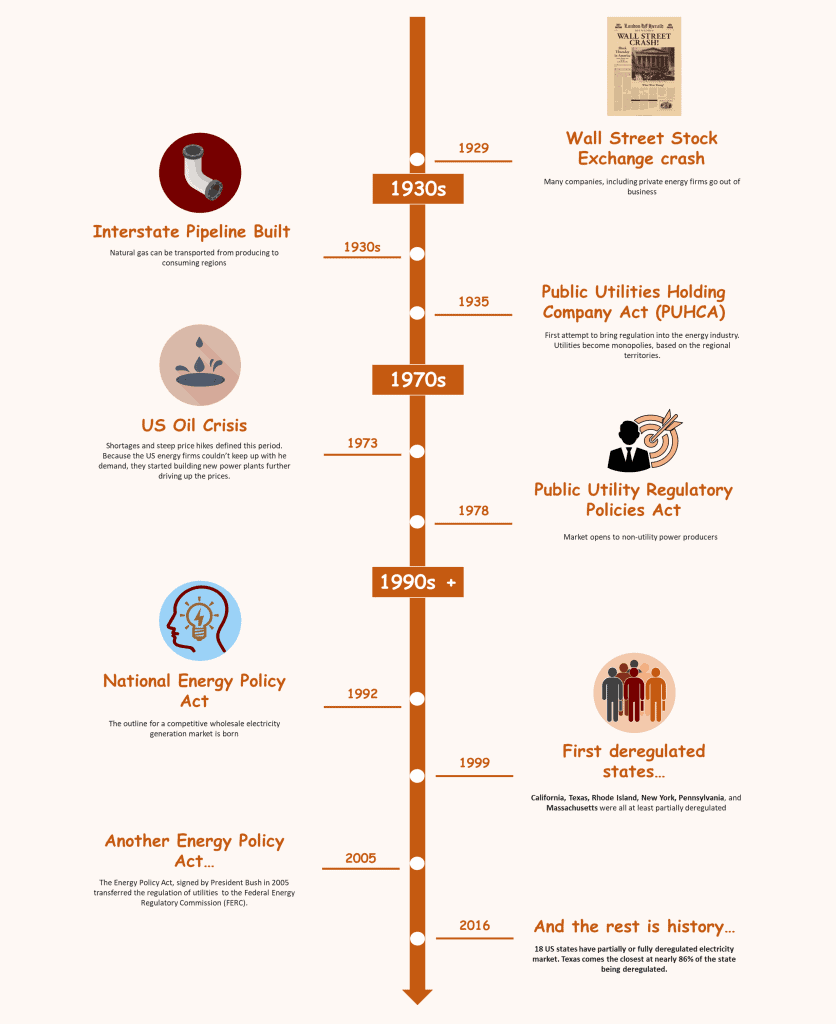How Does Energy Deregulation Work?
Imagine that you would only be able to buy groceries from one supermarket – the one closest to your house – and as a result, this supermarket would be able to charge you a lot higher prices. This was the state of the energy industry in the United States, before the deregulation of electricity market and energy choice.
What Is Energy Deregulation?
Put simply, energy deregulation gives residential and business customers the freedom of choice. Residents in the deregulated electricity states don’t have to purchase electricity from the state utility company for a regulated price. Instead, they can shop around to find more competitive, convenient energy plans from retail energy providers, or REPs.
This might sound like a complicated mission, but the truth is that it’s very simple. You don’t have to be an energy expert or spend hours researching electric and natural gas rates. All you have to do is:
- Know your current electricity price per kilowatt-hour – this is the ‘Supply’ rate on your electric bill (usually expressed in cents per kilowatt-hour)
- Enter your zip code on our website to see all available energy plans available for your area
From there, you are just a few clicks away from locking in a better contract with your new energy supplier.
If you are interested in further details, such as the customer service information, reviews from customers or additional perks that your new supplier offers, we carefully review and vet all major suppliers in the United States, so you can read our review about any one of them.
History of Energy Deregulation

The history of the energy market deregulation in the United States is as rich and colorful as the energy choice that customers have today because of it.
Curiously enough, energy utility companies were not regulated in the early days of the twentieth century. The transmission and distribution assets were owned by privatized companies, that fiercely competed for the same customers including by building duplicate distribution systems in the urban areas.
This era was a win-win for everyone – customers had abundant, low-cost power and utility companies witnessed a period of economic growth and financial gains. But then the Wall Street Stock Exchange crashed in 1929 and many companies, including a number of utilities, went out of business
To secure access to reliable electricity for customers, the US government passed the Public Utility Holding Company Act (often referred to as “PUHCA”) in 1935, and the regulated energy industry was born.
Utilities were bound to their regional territories meaning that customer’s electricity provider was determined by where they lived. This system lasted in the United States until the seventies, which were dominated by rising energy prices and unstable supplies caused by the OPEC oil embargoes.
The US utilities were forced to build new power plants to meet the internal demand for energy, which were expensive, resulting in further price hikes. Our beloved energy industry was yet again in crisis.
The time for the deregulation of the energy market has come.
In 1978, the federal government passed the Public Utility Regulatory Policies Act (PURPA), leaving it up to individual states to decide how to supply energy to energy users; but it wasn’t until the late nineties when California, Texas, Rhode Island, New York, Pennsylvania, and Massachusetts grew into true competition energy markets.
Today there are 18 states with deregulated electricity and 27 states with natural gas, giving customers the power to choose their suppliers.
Benefits of Energy Deregulation
Despite its complicated history, the deregulation of the energy market has brought multiple benefits to the end customer like yourself. What are they?
 | Cheaper energy prices - Due to increased competition, the average electric prices that customers in competitive markets pay are lower compared to the regulated ones. The competition also motives energy suppliers to win customers over with stellar customer service. |
 | New and better products - Apart from cheaper prices, one way that energy suppliers woo in new customers is by offering additional perks, complimentary products, and services. For example, when you choose the Reliant Energy's Learn & Conserve 12 plan, you'll get not only a fixed 12 months energy plan, but also a new Nest Thermostat E at no additional cost ($169 retail price). |
 | Positive environmental impact - One unexpected benefit of the deregulation. Retail energy providers are able to source power from a variety of sources, including renewable generators. As a result, they can offer customers the option to sign up for partially or fully green energy plans, supporting decarbonization. |
Energy Deregulation By State
Despite its benefits, many states continue to regulate the energy industry today. Let’s take a look at the electricity deregulation by state:
| State | Electricity Deregulation | Natural Gas Deregulation | Comments |
|---|---|---|---|
| Alabama | No | No | |
| Alaska | No | No | |
| Arizona | No | No | |
| Arkansas | No | No | |
| California | Yes | Yes | California’s electric choice works on a very limited lottery system called DirectAcccess. |
| Colorado | No | Yes | Colorado law allows natural gas utilities to offer choice programs to consumers, but so far none were proposed. |
| Connecticut | Yes | Yes | Natural gas choice is available statewide for commercial consumers. |
| Delaware | Yes | Yes | Electric choice available widely while natural gaschoice is available for large commercial and industrial consumers. |
| Florida | No | Yes | Natural gas choice is available statewide for commercial and industrial consumers; however, volume requirements differ between utilities. |
| Georgia | No | Yes | Natural gas choice is available for residential and non-residential customers in the AGL utility territory. |
| Hawaii | No | No | |
| Idaho | No | No | |
| Illinois | Yes | Yes | |
| Indiana | 12.41 | 12.17 | $111.65 |
| Iowa | 13.12 | 12.68 | $118.08 |
| Kansas | 12.77 | 13.29 | $114.92 |
| Kentucky | No | Yes | Natural gas choice is available for residential and small commercial consumers in the Columbia Gas utility territory. |
| Louisiana | No | No | |
| Maine | Yes | Yes | |
| Maryland | Yes | Yes | |
| Massachusetts | Yes | Yes | Natural gas choice is available but participation is currently limited. |
| Michigan | 15.82 | 15.55 | $142.41 |
| Minnesota | 13.38 | No | No |
| Mississippi | No | No | |
| Missouri | No | No | |
| Montana | No | Yes | Natural gas choice is available for residential and small commercial consumers in the Northwestern Energy and Energy West Montana utility territories. |
| Nebraska | No | Yes | Natural gas choice is available for residential and non-residential consumers in the SourceGas utility territory during a two-week annual selection period. |
| Nevada | No | Yes | Natural gas choice is available in a limited capacity for commercial and industrial consumers averaging more than 500 therms of gas a day. |
| New Hampshire | Yes | Yes | Natural gas choice is available for commercial and industrial consumers only. |
| New Jersey | Yes | Yes | |
| New Mexico | No | No | Natural Gas Choice is available however, participation is very limited. |
| New York | Yes | Yes | |
| North Carolina | No | No | |
| North Dakota | No | No | |
| Ohio | Yes | Yes | |
| Oklahoma | No | No | |
| Oregon | Yes | No | |
| Pennsylvania | Yes | Yes | |
| Rhode Island | Yes | Yes | Electricity and natural gas choice are available for residential and non-residential consumers in the National Grid utility territory. |
| South Carolina | No | No | |
| South Dakota | No | Yes | Natural gas choice is available for commercial and industrial consumers. |
| Tennessee | No | Yes | Competitive gas service is only available for commercial and industrial customers. |
| Texas | Yes | Yes | Electricity deregulation is available to 85% of Texans. Gas choice is available to commercial customers only. |
| Utah | No | No | |
| Vermont | No | No | |
| Virginia | Yes | Yes | No electricity choice is available for residential consumers, unless consumer is seeking electricity from 100% renewable energy sources, and the local utility does not provide this option. |
| Washington | No | No | |
| West Virginia | No | Yes | Natural gas choice is available statewide including in the Peoples Gas West Virginia, Dominion Energy West Virginia, Consumers Gas Utility, and Mountaineer Gas |
| Wisconsin | No | Yes | Natural gas choice is available in the Wisconsin Public Service utility territory for commercial and industrial consumers. |
| Wyoming | No | Yes | Residential gas choice is available in the SourceGas utility territory. |
However, it’s important to point out that switching suppliers is entirely voluntary in the deregulated energy states and not all customers do. In fact, the US Energy Information Administration points out that participation in the electric customer choice markets remained relatively unchanged since 2013. Possible reasons could be a lack of information or perhaps a perception that switching suppliers is complicated.
That’s why we decided to do the heavy lifting for you. You can read our careful reviews of every major supplier and when you are ready, switch by just entering your zip code and comparing all the available offers in your area.
FAQs
What States Have Deregulation Energy?
Today there are 18 states with a deregulated utility market for electricity and 27 states for natural gas, giving customers the power to choose their suppliers. Customers in California, Connecticut, Delaware, Washington DC, Illinois, Maine, Maryland, New Hampshire, New Jersey, Ohio, Texas, Rhode Island, New York, Pennsylvania, Michigan, Montana, Oregon, and Massachusetts have the choice to switch suppliers for cheaper, more convenient electric rates.
What Are Some Examples of Deregulation?
Apart from the deregulation of energy companies, there are other industries that were deregulated in time to bring down the prices and improve the product line and services for customers. Some prominent examples include the deregulation of telecommunications, mail delivery, airlines, and the financial sector.
Is Ohio a Deregulated Electricity Market?
Ohio has passed the deregulation of the retail energy sector in 2001, allowing its residents to choose the electric and gas – and for what price. Since then, some 50% of residents switched electric suppliers, which according to research, has generated a staggering $15 billion saving on Ohio electric bills.
Updated on




Add Comment
You must be logged in to post a comment.